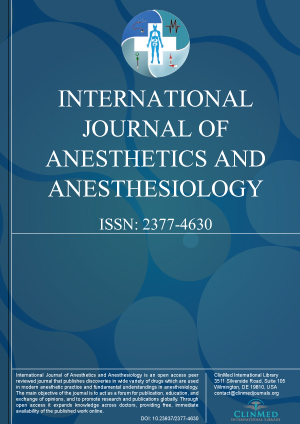Archive
Open Access DOI:10.23937/2377-4630/1410141
Stephanie Opusunju Ibekwe, Noel Shaheen Jeffrey and Shannon Walter Schwenke
Article Type: Case Report | First Published: June 29, 2022
Article Formats
- Full Article
Open Access DOI:10.23937/2377-4630/1410140
Dornelles Marco and Dornelles Larissa
Article Type: Case Report | First Published: June 29, 2022
Article Formats
- Full Article
Open Access DOI:10.23937/2377-4630/1410139
Andualem Assefa Andibirku, Zewde Zema Kanche, Birhanu Wondimeneh Demissie, Tsegaye Demeke G/Medihin, Ashebir Debalke Gemechu and Kirubel Eshetu Haile
Article Type: Research Article | First Published: June 29, 2022
Article Formats
- Full Article
Open Access DOI:10.23937/2377-4630/1410138
Corona Pandemic: Individual Perception Assessment from the Perspective of Anesthesiologist
Ezgi ERKILIC, Cihan DOGER, Yasemin AKCAALAN, M Cem YILMAZ, Tulin GUMUS, Orhan KANBAK, Handan GULEC, Eyup Horasanli, Levent OZTURK3 and Nermin Gogus
Article Type: Research Article | First Published: June 20, 2022
Article Formats
- Full Article
- XML
- EPub Reader
Open Access DOI:10.23937/2377-4630/1410137
Paweł Radkowski PhD, Katarzyna Podhorodecka and Dr Mariusz Keska
Article Type: Case Report | First Published: June 18, 2022
Article Formats
- Full Article
- XML
- EPub Reader
Open Access DOI:10.23937/2377-4630/1410136
Epidural Anesthesia with Opioids in Open Colorectal Surgeries is not Related to Postoperative Ileum
Marina D Ayres, Luana A Ferreira, Davi B Khouri and Jose L Ubaldo
Article Type: Review Article | First Published: May 18, 2022
Article Formats
- Full Article
- XML
- EPub Reader
Open Access DOI:10.23937/2377-4630/1410135
Ajibade Okeyemi, Zakari Aliyu Suleiman, Olanrewaju Olubukola Oyedepo, Benjamin Olusomi Bolaji and Abidemi David Akere
Article Type: Original Article | First Published: May 18, 2022
Article Formats
- Full Article
- XML
- EPub Reader
Open Access DOI:10.23937/2377-4630/1410134
Achmad Munif, Kadek Intan Jelita, I Nyoman Santa Wijaya and Pontisomaya Parami
Article Type: Case Report | First Published: May 18, 2022
Article Formats
- Full Article
- XML
- EPub Reader
Open Access DOI:10.23937/2377-4630/1410133
Unexplained Intraoperative Hypertension and an Electrocautery Burn: A Case Report
Chaeseong Lim, MD, PhD, Yujin Pak, MD, Hanmi Park, MD, Wonhyung Lee, MD, PhD, Seokhwa Yoon, MD, PhD, and Yongsup Shin, MD, PhD
Article Type: Case Report | First Published: March 31, 2022
Article Formats
- Full Article
- XML
- EPub Reader
Open Access DOI:10.23937/2377-4630/1410132
Incidence and Risk factors of Postoperative Nausea and Vomiting after ENT Surgery
Petros K Yosief, Ghirmay G Beraki, Susanna Mayer, Michael B Mengistu and Eyasu H Tesfamariam
Article Type: Research Article | First Published: March 31, 2022
Article Formats
- Full Article
- XML
- EPub Reader
Open Access DOI:10.23937/2377-4630/1410131
Anesthetic Immunomodulation and the Tumor Recurrence: A Narrative Literature Review
Gabriele F Silveira, Isadora AC Fraga, Larissa RM Castro, José Lucas UM Gomes, Marina A Delgado
Article Type: Narrative Review | First Published: March 30, 2022
Article Formats
- Full Article
- XML
- EPub Reader

Volume 9
Issue 1
Issue 1
